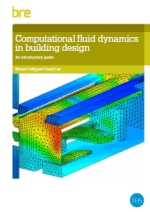Computational fluid dynamics in building design: An introduction FB 69
BRE (Building Research Establishment) is an independent, research-based consultancy, testing and training organisation, operating in the built environment and associated industries.
Computational fluid dynamics in building design: An introduction (FB 69) was written by Richard Chitty and Chunli Cao and published on 15 September 2014.
Computational fluid dynamics (CFD) is a tool that can be used in the design of buildings to simulate aspects of a building's thermal and ventilation performance, fire engineering, its impact on the local environment and so on. For more information see: Computational fluid dynamics.
FB 69 sets out the background to the CFD methodology for non-experts such as building control bodies and other regulatory authorities and discusses the current capabilities and limitations of CFD for building design.
The process of reviewing CFD predictions can be dependent on identifying ‘schoolboy’ errors, such as supersonic wind speeds, using simple sanity checks based on experience of the real world. Visualisation methods often mask the difference between qualitative simulations to demonstrate the feasibility of a concept and quantitative simulations required to prove the functionality of different aspects of design.
The 32-page guide explains best practice, focussing on fire safety, ventilation, thermal comfort and wind movement around buildings.
Its contents include:
- Introduction.
- Computational fluid dynamics explained.
- Computational fluid dynamics in use.
- Fire safety design.
- Ventilation and thermal comfort.
- Wind loading.
- Micro-climate around buildings.
- Case study 1: Fire simulation.
- Case study 2: Natural ventilation.
- References.
[edit] Related articles on Designing Buildings Wiki
- A Practical Guide to Building Thermal Modelling.
- BRE articles on Designing Buildings Wiki.
- BRE Buzz articles on Designing Buildings Wiki.
- BRE Buzz.
- Building Research Establishment.
- Computational fluid dynamics.
- Conventions for calculating linear thermal transmittance and temperature factors.
- Dynamic thermal modelling of closed loop geothermal heat pump systems.
- Heat transfer.
- Indoor air velocity.
- Integrating CFD into the design process.
- Mass transfer.
- The design of temporary structures and wind adjacent to tall buildings.
- The thermal behaviour of spaces enclosed by fabric membranes (Thesis).
- Thermal dynamic analysis.
Featured articles and news
ECA progress on Welsh Recharging Electrical Skills Charter
Working hard to make progress on the ‘asks’ of the Recharging Electrical Skills Charter at the Senedd in Wales.
A brief history from 1890s to 2020s.
CIOB and CORBON combine forces
To elevate professional standards in Nigeria’s construction industry.
Amendment to the GB Energy Bill welcomed by ECA
Move prevents nationally-owned energy company from investing in solar panels produced by modern slavery.
Gregor Harvie argues that AI is state-sanctioned theft of IP.
Heat pumps, vehicle chargers and heating appliances must be sold with smart functionality.
Experimental AI housing target help for councils
Experimental AI could help councils meet housing targets by digitising records.
New-style degrees set for reformed ARB accreditation
Following the ARB Tomorrow's Architects competency outcomes for Architects.
BSRIA Occupant Wellbeing survey BOW
Occupant satisfaction and wellbeing tool inc. physical environment, indoor facilities, functionality and accessibility.
Preserving, waterproofing and decorating buildings.
Many resources for visitors aswell as new features for members.
Using technology to empower communities
The Community data platform; capturing the DNA of a place and fostering participation, for better design.
Heat pump and wind turbine sound calculations for PDRs
MCS publish updated sound calculation standards for permitted development installations.
Homes England creates largest housing-led site in the North
Successful, 34 hectare land acquisition with the residential allocation now completed.
Scottish apprenticeship training proposals
General support although better accountability and transparency is sought.
The history of building regulations
A story of belated action in response to crisis.
Moisture, fire safety and emerging trends in living walls
How wet is your wall?
Current policy explained and newly published consultation by the UK and Welsh Governments.
British architecture 1919–39. Book review.
Conservation of listed prefabs in Moseley.
Energy industry calls for urgent reform.





























